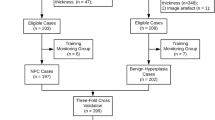Abstract
Gadolinium-enhanced magnetic resonance imaging (MRI) is widely used to detect recurrent nasal tumours. A specifically designed two-layer Hopfield neural network, called the spatiotemporal Hopfield neural cube (SHNC), is presented, to be used for detecting recurrent nasal papilloma. Differing from conventional, two-dimensional Hopfield neural networks, the SHNC extends the one-layer, two-dimensional Hopfield network in the original image plane into a two-layer, three-dimensional (3D) Hopfield network with pixel classification implemented in its third dimension. With extended 3D architecture, the network is able to use each pixel's spatial information in a pixel labelling procedure. Because the SHNC takes pixel spatial information into consideration, the effects of tiny detail or noise are removed. As a result, the drawback of disconnected fractions can be avoided. Furthermore, owing to the incorporation of competitive learning rules to update neuron states, to avoid the problem of having to satisfy strong constraints, the convergence of the network was improved. In addition, a more accurate signal-time curve, the relative intensity change (RIC), was adopted to represent the gadolinium-enhanced MRI temporal information, and the RIC curves of recurrent nasal papilloma were incorporated into the SHNC. The experimental results showed that the SHNC could obtain a more appropriate, precise position of recurrent nasal papilloma than the k-means, principal components analysis (PCA) or Eigenimagefiltering methods. The average sensitivity and specificity of the 26 cases were 0.9998 and 0.9961, respectively. These values demonstrate the effectiveness of the proposed technique.
Similar content being viewed by others
References
Brix, G., Semmler, W., Port, R. L., Schad, R., Layer, G., andLorenz, W. J. (1991): ‘Pharmacokinetic parameters in CNS Gd-DTPA enhanced MR image’,J. Comput. Assist. Tomogr.,15, pp. 621–628
Chang, C. Y., andChung, P. C. (2000): ‘Two-layer competitive based Hopfield neural network for medical image edge detection’,Opt. Eng.,39, pp. 695–703
Chang, C. Y., Chung, P. C., Huang, W. C., andLai, P. H. (2000): ‘An Eigen-support differential operator to fuse CT and MR images for nasopharyngeal carcinoma diagnosis’,Biomed. Eng. Appl., Basis Comm.,12, pp. 101–109
Chang, C. Y., Chung, P. C., andLai, P. H. (2002): ‘Using a spatiotemporal neural network on dynamic gadolinium-enhanced MR images for diagnosing recurrent nasal papilloma’,IEEE Trans. Nucl. Sci.,49, pp. 225–238
Cheng, K. S., Lin, J. S., andMao, C. W. (1996): ‘The application of competitive Hopfield neural network to medical image segmentation’,IEEE Trans. Med. Imag.,15, pp. 560–567
Chung, P. C., Tsai, C. T., Chen, E. L., andSun, Y. N. (1994): ‘Polygonal approximation using a competitive Hopfield neural network’,Pattern Recog.,27, pp. 1505–1512
Huang, W. C., Hsu, C. C., Lee, C. N., andLai, P. H. (1999): ‘Recurrent nasal tumor detection by dynamic MRI’,IEEE Eng. Med. Biol., pp. 100–105
Lai, P. H., Yang, C. F., Pan, H. B., Wu, M. T., Chu, S. T., Ger, L. P., Huang, W. C., Hsu, C. C., andLee, C. N. (1999): ‘Recurrent inverted papilloma: diagnosis with pharmacokinetic dynamic gadolinium-enhanced MR imaging’,Am. J. Neuroradiol.,20, pp. 1445–1451
Lawson, W., Ho, B. T., Shaari, C. M., andBiller, H. F. (1995): ‘Inverted papilloma: a report of 112 cases’,Laryngoscope,105, pp. 282–288
Li, S. Z. (1998): ‘MAP image restoration and segmentation by constrained optimization’,IEEE Trans. Image Process.,7, pp. 1730–1735
Manuel, G. P., Maria, J. C., Antonio, M., andCabello, D. (1998): ‘Computer-aided diagnosis: a neural-network-based approach to lung nodule detection’,IEEE Trans. Med. Imag.,17, pp. 872–880
Muller, S. M., Brix, G., Layer, G., Schlag, P., Engenhart, R., Frohmuller, S., Hess, T., Zuna, I., Semmler, W., van Kaick, G. (1993): ‘Recurrent rectal cancer diagnosis with dynamic MR image’,Radiology,189, pp. 881–889
Ortendahl, D. A. (1986). ‘The application of principal component analysis to multivariate MRI data’. IEEE/8th Ann. Conf. Eng. Med. Biol. Soc., pp. 1065–1068
Pappas, T. (1992): ‘An adaptive clustering algorithm for image segmentation’,IEEE Trans. Signal Process.,40, pp. 901–914.
Sammouda, R., Niki, N., andNishitani, H. (1997): ‘Hopfield neural network for the multichannel segmentation of magnetic resonance cerebral images.Pattern Recogn.,30, pp. 921–927
Unser, M., andEden, M. (1990): ‘Weighted averaging of a set of noisy images for maximum signal-to-noise ratio’,IEEE Trans. Acoust Speech Signal Process.,38, pp. 890–895
Windham, J. P., Abdallah, M. A., Reimaun, D. A., Froelich, J. W., andHaggar, A. M. (1988): ‘Eigenimage filtering in MR imaging’,J. Comput. Ass. Tomogr.,12, pp. 1–9
Author information
Authors and Affiliations
Corresponding author
Rights and permissions
About this article
Cite this article
Chang, C.Y. Spatiotemporal Hopfield neural cube for diagnosing recurrent nasal papilloma. Med. Biol. Eng. Comput. 43, 16–22 (2005). https://doi.org/10.1007/BF02345118
Received:
Accepted:
Issue Date:
DOI: https://doi.org/10.1007/BF02345118




